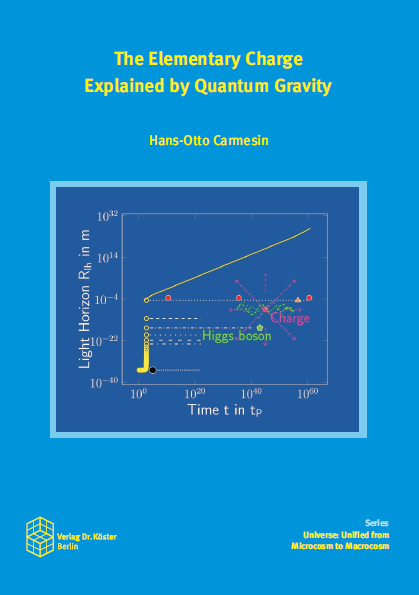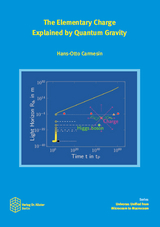The Elementary Charge Explained by Quantum Gravity
Seiten
Question
Our observable universe ranges from the light horizon at a distance of 4.1 ∙ 1026 m towards the Planck scale at lengths of 1.6 ∙ 10-35 m. Corresponding bodies are galaxy clusters, our home region of galaxies Laniakea, our Milky Way, our Solar System, Earth, cities, villages, houses, ourselves and elementary particles. How do these different bodies interact?
The heavenly bodies mainly interact by gravity. In contrast, most forces among bodies of everyday life are based on the electric interaction. Gravity and the electric interaction are regarded as two fundamental interactions. However, are these two interactions really fundamentally different?
Discovery
We discover the formation of the elementary charge based on quantum gravity. Hereby the difference between theory and experiment amounts to five millionth of a percent. Of course, we use no fit parameters. We show how classical electrodynamics and quantum electrodynamics are both based on our finding.
Perspective
I derived a new theory of quantum gravity. It describes physics ranging from the Planck scale towards the light horizon. With it, I discovered results in cosmology, general relativity and particle physics:
In the standard model of cosmology, there are six parameters. One is independent, as it describes the time after the Big Bang. I derived the other parameters from quantum gravity, using no fit.
The standard model of elementary particles essentially describes masses of particles and three fundamental interactions: electric, weak and strong interaction.
Using quantum gravity, I derived the mass of the Higgs boson, which in turn causes the masses of the other particles, except neutrinos. For these, I derived the cosmological constant of neutrino masses.
In this book, we apply the above findings in order to derive the formation of the elementary charge and electric interaction. So the electric charge and electric interaction are not fundamental.
It will be interesting and challenging to use a theory ranging from the Planck scale towards the light horizon, in order to investigate other properties of elementary particles.
Comprehensive Explanation
In this book we derive all findings in a systematic, clear and smooth manner. We summarize our results by many definitions, propositions and theorems. We are classes from grade 10 or higher, courses, research clubs, enthusiasts, observers, experimentalists, mathematicians, natural scientists, researchers …
Our observable universe ranges from the light horizon at a distance of 4.1 ∙ 1026 m towards the Planck scale at lengths of 1.6 ∙ 10-35 m. Corresponding bodies are galaxy clusters, our home region of galaxies Laniakea, our Milky Way, our Solar System, Earth, cities, villages, houses, ourselves and elementary particles. How do these different bodies interact?
The heavenly bodies mainly interact by gravity. In contrast, most forces among bodies of everyday life are based on the electric interaction. Gravity and the electric interaction are regarded as two fundamental interactions. However, are these two interactions really fundamentally different?
Discovery
We discover the formation of the elementary charge based on quantum gravity. Hereby the difference between theory and experiment amounts to five millionth of a percent. Of course, we use no fit parameters. We show how classical electrodynamics and quantum electrodynamics are both based on our finding.
Perspective
I derived a new theory of quantum gravity. It describes physics ranging from the Planck scale towards the light horizon. With it, I discovered results in cosmology, general relativity and particle physics:
In the standard model of cosmology, there are six parameters. One is independent, as it describes the time after the Big Bang. I derived the other parameters from quantum gravity, using no fit.
The standard model of elementary particles essentially describes masses of particles and three fundamental interactions: electric, weak and strong interaction.
Using quantum gravity, I derived the mass of the Higgs boson, which in turn causes the masses of the other particles, except neutrinos. For these, I derived the cosmological constant of neutrino masses.
In this book, we apply the above findings in order to derive the formation of the elementary charge and electric interaction. So the electric charge and electric interaction are not fundamental.
It will be interesting and challenging to use a theory ranging from the Planck scale towards the light horizon, in order to investigate other properties of elementary particles.
Comprehensive Explanation
In this book we derive all findings in a systematic, clear and smooth manner. We summarize our results by many definitions, propositions and theorems. We are classes from grade 10 or higher, courses, research clubs, enthusiasts, observers, experimentalists, mathematicians, natural scientists, researchers …
| Erscheinungsdatum | 29.10.2021 |
|---|---|
| Reihe/Serie | Universe: Unified from Microcosm to Macrocosm ; 6 |
| Verlagsort | Berlin |
| Sprache | englisch |
| Maße | 148 x 210 mm |
| Themenwelt | Naturwissenschaften ► Physik / Astronomie ► Astronomie / Astrophysik |
| Naturwissenschaften ► Physik / Astronomie ► Quantenphysik | |
| Naturwissenschaften ► Physik / Astronomie ► Theoretische Physik | |
| Schlagworte | Gravitation • Kosmologie • Planck-Skala • Quantengravitation |
| ISBN-10 | 3-96831-023-3 / 3968310233 |
| ISBN-13 | 978-3-96831-023-7 / 9783968310237 |
| Zustand | Neuware |
| Haben Sie eine Frage zum Produkt? |
Mehr entdecken
aus dem Bereich
aus dem Bereich
Grundlagen, Anwendungen in Astrophysik und Kosmologie sowie …
Buch | Softcover (2022)
Springer Spektrum (Verlag)
CHF 69,95
die Geschichte und Erforschung unserer Galaxie
Buch | Hardcover (2023)
C.Bertelsmann (Verlag)
CHF 40,80
Von Hubble-, James-Webb- und anderen Großteleskopen bis zu …
Buch | Softcover (2024)
Springer (Verlag)
CHF 32,15




